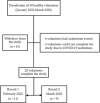Individual variability in patterns and dynamics of fecal gluten immunogenic peptides excretion after low gluten intake
- PMID: 34993643
- PMCID: PMC8739026
- DOI: 10.1007/s00394-021-02765-z
Individual variability in patterns and dynamics of fecal gluten immunogenic peptides excretion after low gluten intake
Abstract
Purpose: Determination of Gluten Immunogenic Peptides (GIP) in feces is a direct tool for gluten exposure detection. The sensitivity of GIP detection methods for cases of unintentional low gluten intakes is unknown. We studied the interindividual variability in the kinetic of excretion under homogeneously controlled dietary conditions, and the sensitivity of fecal GIP tests after low amounts of punctual gluten ingestions.
Methods: Participants (n = 20) followed the same gluten-free menu for 12 days in which two separated doses of gluten (50 mg and 2 g) were ingested and all the depositions were collected. GIP from stool samples were analyzed by ELISA and lateral flow immunoassay (LFIA) tests.
Results: Most participants had detectable GIP after 50 mg and 2 g gluten ingestions using ELISA test (72.2% and 95%, respectively), whereas the LFIA test showed less sensitivity (22.2% and 80%, respectively). GIP were detected at higher either frequency or concentration in the range of 12-36 h after 50 mg intake, and 12-84 h after 2 g consumption. Considering this period, diagnostic sensitivity of GIP detection after a single 50 mg ingestion may be significatively increased analyzing three stool samples per individual. High variability among participants was found in the time and amount of GIP excretion; however, some individuals showed common patterns for both gluten intakes.
Conclusion: Sporadic gluten exposure detection may require several fecal samples to achieve level of sensitivity above 90%. Interindividual variability in the dynamic of GIP excretion may suggest patterns of gluten metabolism.
Keywords: Celiac disease; Gluten detection feces; Gluten immunogenic peptides; Gluten metabolism; Gluten-free diet monitoring.
© 2022. The Author(s).
Conflict of interest statement
Angel Cebolla is the founder and current CEO of Biomedal S.L. (Seville, Spain), Angel Cebolla and Carolina Sousa are inventors of the patent “Detecting gluten peptides in human fluids” (no. WO/2016/005643), and Laura Coto is employee at Biomedal S.L.
Figures











References
MeSH terms
Substances
Grants and funding
LinkOut - more resources
Full Text Sources
Medical

